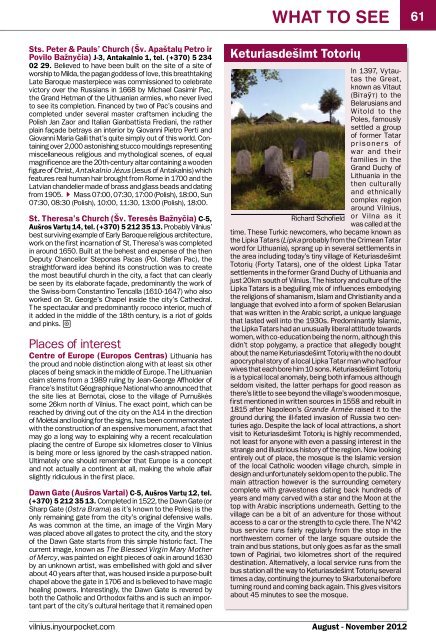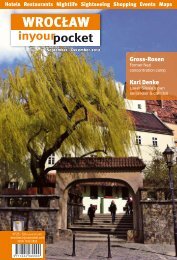VILNIUS - In Your Pocket
VILNIUS - In Your Pocket
VILNIUS - In Your Pocket
Create successful ePaper yourself
Turn your PDF publications into a flip-book with our unique Google optimized e-Paper software.
Sts. Peter & Pauls’ Church (Šv. Apaštalų Petro ir<br />
Povilo Bažnyčia) J-3, Antakalnio 1, tel. (+370) 5 234<br />
02 29. Believed to have been built on the site of a site of<br />
worship to Milda, the pagan goddess of love, this breathtaking<br />
Late Baroque masterpiece was commissioned to celebrate<br />
victory over the Russians in 1668 by Michael Casimir Pac,<br />
the Grand Hetman of the Lithuanian armies, who never lived<br />
to see its completion. Financed by two of Pac’s cousins and<br />
completed under several master craftsmen including the<br />
Polish Jan Zaor and Italian Gianbattista Frediani, the rather<br />
plain façade betrays an interior by Giovanni Pietro Perti and<br />
Giovanni Maria Galli that’s quite simply out of this world. Containing<br />
over 2,000 astonishing stucco mouldings representing<br />
miscellaneous religious and mythological scenes, of equal<br />
magnificence are the 20th-century altar containing a wooden<br />
figure of Christ, Antakalnio Jėzus (Jesus of Antakalnis) which<br />
features real human hair brought from Rome in 1700 and the<br />
Latvian chandelier made of brass and glass beads and dating<br />
from 1905. Q Mass 07:00, 07:30, 17:00 (Polish), 18:00, Sun<br />
07:30, 08:30 (Polish), 10:00, 11:30, 13:00 (Polish), 18:00.<br />
St. Theresa’s Church (Šv. Teresės Bažnyčia) C-5,<br />
Aušros Vartų 14, tel. (+370) 5 212 35 13. Probably Vilnius’<br />
best surviving example of Early Baroque religious architecture,<br />
work on the first incarnation of St. Theresa’s was completed<br />
in around 1650. Built at the behest and expense of the then<br />
Deputy Chancellor Steponas Pacas (Pol. Stefan Pac), the<br />
straightforward idea behind its construction was to create<br />
the most beautiful church in the city, a fact that can clearly<br />
be seen by its elaborate façade, predominantly the work of<br />
the Swiss-born Constantino Tencalla (1610-1647) who also<br />
worked on St. George’s Chapel inside the city’s Cathedral.<br />
The spectacular and predominantly rococo interior, much of<br />
it added in the middle of the 18th century, is a riot of golds<br />
and pinks. J<br />
Places of interest<br />
Centre of Europe (Europos Centras) Lithuania has<br />
the proud and noble distinction along with at least six other<br />
places of being smack in the middle of Europe. The Lithuanian<br />
claim stems from a 1989 ruling by Jean-George Affholder of<br />
France’s <strong>In</strong>stitut Géographique National who announced that<br />
the site lies at Bernotai, close to the village of Purnuškės<br />
some 26km north of Vilnius. The exact point, which can be<br />
reached by driving out of the city on the A14 in the direction<br />
of Molėtai and looking for the signs, has been commemorated<br />
with the construction of an expensive monument, a fact that<br />
may go a long way to explaining why a recent recalculation<br />
placing the centre of Europe six kilometres closer to Vilnius<br />
is being more or less ignored by the cash-strapped nation.<br />
Ultimately one should remember that Europe is a concept<br />
and not actually a continent at all, making the whole affair<br />
slightly ridiculous in the first place.<br />
Dawn Gate (Aušros Vartai) C-5, Aušros Vartų 12, tel.<br />
(+370) 5 212 35 13. Completed in 1522, the Dawn Gate (or<br />
Sharp Gate (Ostra Brama) as it’s known to the Poles) is the<br />
only remaining gate from the city’s original defensive walls.<br />
As was common at the time, an image of the Virgin Mary<br />
was placed above all gates to protect the city, and the story<br />
of the Dawn Gate starts from this simple historic fact. The<br />
current image, known as The Blessed Virgin Mary Mother<br />
of Mercy, was painted on eight pieces of oak in around 1630<br />
by an unknown artist, was embellished with gold and silver<br />
about 40 years after that, was housed inside a purpose-built<br />
chapel above the gate in 1706 and is believed to have magic<br />
healing powers. <strong>In</strong>terestingly, the Dawn Gate is revered by<br />
both the Catholic and Orthodox faiths and is such an important<br />
part of the city’s cultural heritage that it remained open<br />
vilnius.inyourpocket.com<br />
what to see<br />
Keturiasdešimt Totorių<br />
<strong>In</strong> 1397, Vytautas<br />
the Great,<br />
known as Vitaut<br />
(Вітаўт) to the<br />
Belarusians and<br />
Witold to th e<br />
Poles, famously<br />
settled a group<br />
of former Tatar<br />
p r i s o n e r s o f<br />
war and their<br />
families in the<br />
Grand Duchy of<br />
Lithuania in the<br />
then culturally<br />
and ethnically<br />
complex region<br />
around Vilnius,<br />
Richard Schofield<br />
or Vilna as it<br />
was called at the<br />
time. These Turkic newcomers, who became known as<br />
the Lipka Tatars (Lipka probably from the Crimean Tatar<br />
word for Lithuania), sprang up in several settlements in<br />
the area including today’s tiny village of Keturiasdešimt<br />
Totorių (Forty Tatars), one of the oldest Lipka Tatar<br />
settlements in the former Grand Duchy of Lithuania and<br />
just 20km south of Vilnius. The history and culture of the<br />
Lipka Tatars is a beguiling mix of influences embodying<br />
the religions of shamanism, Islam and Christianity and a<br />
language that evolved into a form of spoken Belarusian<br />
that was written in the Arabic script, a unique language<br />
that lasted well into the 1930s. Predominantly Islamic,<br />
the Lipka Tatars had an unusually liberal attitude towards<br />
women, with co-education being the norm, although this<br />
didn’t stop polygamy, a practice that allegedly bought<br />
about the name Keturiasdešimt Totorių with the no doubt<br />
apocryphal story of a local Lipka Tatar man who had four<br />
wives that each bore him 10 sons. Keturiasdešimt Totorių<br />
is a typical local anomaly, being both infamous although<br />
seldom visited, the latter perhaps for good reason as<br />
there’s little to see beyond the village’s wooden mosque,<br />
first mentioned in written sources in 1558 and rebuilt in<br />
1815 after Napoleon’s Grande Armée raised it to the<br />
ground during the ill-fated invasion of Russia two centuries<br />
ago. Despite the lack of local attractions, a short<br />
visit to Keturiasdešimt Totorių is highly recommended,<br />
not least for anyone with even a passing interest in the<br />
strange and illustrious history of the region. Now looking<br />
entirely out of place, the mosque is the Islamic version<br />
of the local Catholic wooden village church, simple in<br />
design and unfortunately seldom open to the public. The<br />
main attraction however is the surrounding cemetery<br />
complete with gravestones dating back hundreds of<br />
years and many carved with a star and the Moon at the<br />
top with Arabic inscriptions underneath. Getting to the<br />
village can be a bit of an adventure for those without<br />
access to a car or the strength to cycle there. The N°42<br />
bus service runs fairly regularly from the stop in the<br />
northwestern corner of the large square outside the<br />
train and bus stations, but only goes as far as the small<br />
town of Pagiriai, two kilometres short of the required<br />
destination. Alternatively, a local service runs from the<br />
bus station all the way to Keturiasdešimt Totorių several<br />
times a day, continuing the journey to Skarbutenai before<br />
turning round and coming back again. This gives visitors<br />
about 45 minutes to see the mosque.<br />
August - November 2012<br />
61
















